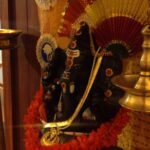
Gaṇeś Caturthi or Vinayaka Caturthi, the birthday of Lord Gaṇeś a, is one of the most popular Hindu festivals celebrated throughout India and by Hindu around the world.
 The festival of Ganesh Chaturthi takes place in the Bhadrapada month of the Hindu calendar and it is celebrated for 10 days.
The festival of Ganesh Chaturthi takes place in the Bhadrapada month of the Hindu calendar and it is celebrated for 10 days.
During these 10 days, people follow a lot of rituals which include erecting a pandal or a temporary podium for installing the idol, performing the aarti, the offering of prasad especially Modak which is considered to be Lord Ganesha’s, favorite sweet.
Lord Ganesha’s blessings are considered very auspicious before beginning any kind of work and hence he is one of the most worshipped deities.
Gaṇeś (also spelled Ganesa or Gaṇeś a and known as Gaṇapati, Vinayaka and Pillaiyar) is the Lord of Good Fortune who provides prosperity, fortune and success. He is the Lord of Beginnings and the Remover of Obstacles of both material and spiritual kinds.
Gaṇeśa, in fact, is the symbol of he who has discovered the Divinity within himself.
Gaṇeśa is the first sound, OM, in which all hymns were born. When Śakti (Energy) and Śiva (Matter) meet, both Sound (Gaṇeś a) and Light (Skanda) were born. He represents the perfect equilibrium between force and kindness and between power and beauty. He also symbolizes the discriminative capacities which provide the ability to perceive distinctions between truth and illusion, the real and the unreal.
A description of all of the characteristics and attributes of Gaṇeś a can be found in the Gaṇapati Upanishad (an Upanishad dedicated to Gaṇeś a) of the rishi Atharva, in which Gaṇeś a is identified with Brahman and Atman.
Gaṇeś a became the Lord (Isha) of all existing beings (Gana) after winning a contest from hisbrother Kartikay. When given the task to race around the universe, Gaṇeś a did not start the race like Kartikay did, but simply walked around Śiva and Parvati, both his father and mother as the source of all existence Gaṇeś a (Gaṇeś ) rides a rat that represents the subjugated demon of vanity and impertinence. The conch represents the sound that creates Akash. The laddu (sweet) represents Sattva. The snakes represent control over the poisons of the passions and refer to Śiva, father of Gaṇeś a. The hatchet cuts away the bondage of desires. The mudra grants fearlessness. The broken tusk is the one with which Gaṇeś a wrote the Mahabaratha.
Gaṇeś a is the consort of Buddhi and Siddhi, daughters of Brahma. 'Ga' symbolizes Buddhi(intellect) and 'Na' symbolizes Vidnyana (wisdom). Gaṇeś a is thus considered the master of intellect and wisdom. Gaṇeś a is also often portrayed along with Saraswati and Lakshmi, symbolising that success and beauty always accompany wisdom.
Traditionally, Gaṇeś a comes in 32 different forms. One for example is Heramba Vinayakar, the Pancha Muga Gaṇeś a or five-faced Gaṇeś a. This form is specifically known as the protector of the weak. This ten-armed Gaṇeś a is seated on a lion instead of the usual rat. He extends the gestures of protection and blessing while holding a noose, prayer (japa) beads, axe, hammer, tusk, garland, fruit and modaka
Gaṇeśa is one of the most popular and well-known of all the Hindu gods and is always worshipped first. He is the god of Wisdom and the patron of learning.
Gaṇeśa has two wives Siddhi — Success, and Buddhi — intelligence sometime his second wife is said to be Riddhi — Prosperity.
Gaṇeśa represents one of the basic concepts of Hindu Philosophy — the identity between the macrocosm and the microcosm. In religious terms this is the identity between the individual and the universe (humankind made in the image of God). This idea of the potential divinity of the person and the immanence of God should be presented in the mind before beginning any undertaking. This is the reason that Gaṇeśa is worshiped at the beginning of every enterprise. Not only this but his icon is seen at the entrance to almost every Hindu home and on every altar.
In iconography Gaṇeśa is represented as an Elephant-headed man. The man part of Gaṇeśa represents the manifest Principle which is subordinate to the unmanifest Principle which is represented by the elephant's head. The elephant head also represents certain qualities to which a sincere spiritual seeker is encouraged to aspire — strength, intelligence, endurance and gracefulness. The elephant is the only animal which has all it's 5 organs in the head. Thus we are taught that exerting control over the five senses is an essential pre-requisite to achieving knowledge and wisdom.